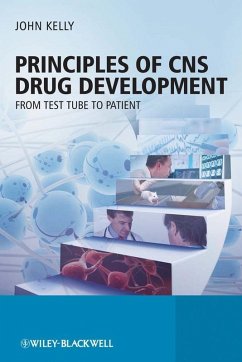125,99 €
125,99 €
inkl. MwSt.
Sofort per Download lieferbar

0 °P sammeln
125,99 €
Als Download kaufen

125,99 €
inkl. MwSt.
Sofort per Download lieferbar

0 °P sammeln
Jetzt verschenken
Alle Infos zum eBook verschenken
125,99 €
inkl. MwSt.
Sofort per Download lieferbar
Alle Infos zum eBook verschenken

0 °P sammeln
- Format: PDF
- Merkliste
- Auf die Merkliste
- Bewerten Bewerten
- Teilen
- Produkt teilen
- Produkterinnerung
- Produkterinnerung

Bitte loggen Sie sich zunächst in Ihr Kundenkonto ein oder registrieren Sie sich bei
bücher.de, um das eBook-Abo tolino select nutzen zu können.
Hier können Sie sich einloggen
Hier können Sie sich einloggen
Sie sind bereits eingeloggt. Klicken Sie auf 2. tolino select Abo, um fortzufahren.

Bitte loggen Sie sich zunächst in Ihr Kundenkonto ein oder registrieren Sie sich bei bücher.de, um das eBook-Abo tolino select nutzen zu können.
This title acts as a primer, giving students and newcomers to the field an opportunity to learn about the breadth of the CNS drug discovery. The book outlines the core processes in drug discovery and development for CNS disorders, from evaluating drugs for desirable efficacy, safety and pharmacokinetic features in preclinical (using in vitro and in vivo models) and clinical experimentation to identifying future drug targets. Containing up-to-date experimental evidence and detailing the main impediments in the pipeline of CNS drug discovery and development, this is a key reference for those…mehr
- Geräte: PC
- mit Kopierschutz
- eBook Hilfe
- Größe: 2.68MB
Andere Kunden interessierten sich auch für
![Understanding Nicotine and Tobacco Addiction (eBook, PDF) Understanding Nicotine and Tobacco Addiction (eBook, PDF)]() Understanding Nicotine and Tobacco Addiction (eBook, PDF)163,99 €
Understanding Nicotine and Tobacco Addiction (eBook, PDF)163,99 €![Introduction to Neuropsychopharmacology (eBook, PDF) Introduction to Neuropsychopharmacology (eBook, PDF)]() Leslie IversenIntroduction to Neuropsychopharmacology (eBook, PDF)32,95 €
Leslie IversenIntroduction to Neuropsychopharmacology (eBook, PDF)32,95 €![Clinical Physiology and Pharmacology (eBook, PDF) Clinical Physiology and Pharmacology (eBook, PDF)]() Farideh JavidClinical Physiology and Pharmacology (eBook, PDF)56,99 €
Farideh JavidClinical Physiology and Pharmacology (eBook, PDF)56,99 €![Purinergic Signalling in Neuron-Glia Interactions (eBook, PDF) Purinergic Signalling in Neuron-Glia Interactions (eBook, PDF)]() Purinergic Signalling in Neuron-Glia Interactions (eBook, PDF)149,99 €
Purinergic Signalling in Neuron-Glia Interactions (eBook, PDF)149,99 €![Pharmacology for the Health Care Professions (eBook, PDF) Pharmacology for the Health Care Professions (eBook, PDF)]() Christine M. ThorpPharmacology for the Health Care Professions (eBook, PDF)50,99 €
Christine M. ThorpPharmacology for the Health Care Professions (eBook, PDF)50,99 €![Filling-In (eBook, PDF) Filling-In (eBook, PDF)]() Filling-In (eBook, PDF)39,95 €
Filling-In (eBook, PDF)39,95 €![The Clinical Anatomy of the Cranial Nerves (eBook, PDF) The Clinical Anatomy of the Cranial Nerves (eBook, PDF)]() Joel A. VilenskyThe Clinical Anatomy of the Cranial Nerves (eBook, PDF)76,99 €
Joel A. VilenskyThe Clinical Anatomy of the Cranial Nerves (eBook, PDF)76,99 €-
-
-
This title acts as a primer, giving students and newcomers to the field an opportunity to learn about the breadth of the CNS drug discovery. The book outlines the core processes in drug discovery and development for CNS disorders, from evaluating drugs for desirable efficacy, safety and pharmacokinetic features in preclinical (using in vitro and in vivo models) and clinical experimentation to identifying future drug targets. Containing up-to-date experimental evidence and detailing the main impediments in the pipeline of CNS drug discovery and development, this is a key reference for those involved in all stages of CNS drug discovery. Key Features: * Discusses in detail the key stages of CNS drug discovery, outlining the particular requirements and obstacles for CNS drugs * Addresses safety concerns and future drug targets * Provides succinct background information about the major CNS diseases * Examples of specific drugs are used throughout to describe the development of a new drug from conception to clinical use and post-market surveillance * Primary reasons for drug failure are given for each stage
Dieser Download kann aus rechtlichen Gründen nur mit Rechnungsadresse in D ausgeliefert werden.
Produktdetails
- Produktdetails
- Verlag: John Wiley & Sons
- Erscheinungstermin: 27. Oktober 2009
- Englisch
- ISBN-13: 9780470682913
- Artikelnr.: 37298874
- Verlag: John Wiley & Sons
- Erscheinungstermin: 27. Oktober 2009
- Englisch
- ISBN-13: 9780470682913
- Artikelnr.: 37298874
- Herstellerkennzeichnung Die Herstellerinformationen sind derzeit nicht verfügbar.
Dr. John Kelly, Senior Lecturer, Department of Pharmacology and Therapeutics, NUI, Galway, Ireland.
Acknowledgements.
Preface.
Abbreviations.
1 Introduction.
1.1 The global burden of CNS disease.
1.2 Assessment of the global burden of disease.
1.3 The prevalence of CNS disorders.
1.4 Disability due to CNS disorders.
1.5 Economic Costs.
1.6 Concluding comments.
References.
2 An overview of the major CNS disorders.
2.1 Introduction.
2.2 Overview of psychiatric disorders.
2.3 Overview of neurological/neurodegenerative disorders.
2.4 Concluding comments.
References.
3 Neurobiological substrates of CNS disorders.
3.1 Introduction.
3.2 Brief introduction to the principles of chemical neurotransmission.
3.3 Stages of chemical neurotransmission.
3.4 Approaches to investigating CNS alterations in CNS disorders.
3.5 Evidence for a neurobiological rationale for CNS disorders.
3.6 Concluding comments.
References.
4 Current pharmacological targets.
4.1 Introduction.
4.2 Pharmacological treatments for depression.
4.3 Pharmacological treatments for schizophrenia.
4.4 Pharmacological treatments for anxiety disorders.
4.5 Pharmacological treatments for epilepsy.
4.6 Pharmacological treatments for Parkinson's disease.
4.7 Pharmacological treatments for Alzheimer's disease.
4.8 Concluding comments.
References.
5 Premarketing efficacy evaluation.
5.1 Introduction.
5.2 Target identification.
5.3 Lead optimisation.
5.4 Target validation in animal models.
5.5 The use of genetically modified animals in CNS drug development.
5.6 A selection of animal models of psychiatric disease.
5.7 A selection of animal models of neurodegenerative disease.
5.8 Which models to choose.
5.9 Clinical trials that evaluate drug efficacy.
5.10 Specific drug profiles.
References.
6 Pharmacokinetic considerations: Absorption, distribution, metabolism and
elimination.
6.1 Introduction.
6.2 What are the 'ideal' pharmacokinetic properties for a CNS drug?
6.3 Absorption.
6.4 Distribution.
6.5 Metabolism.
6.6 Elimination.
6.7 Measurement of drug concentrations.
6.8 Factors that affect pharmacokinetics.
6.9 Allometric scaling.
6.10 Microdosing (Phase 0) Studies.
6.11 Dose prediction and therapeutic drug monitoring.
6.12 Stereoselectivity of metabolism of drugs.
6.13 Specific drug profiles.
6.14 Concluding comments.
References.
7 Safety concerns.
7.1 Introduction.
7.2 Postmarketing surveillance.
7.3 Acute poisoning.
7.4 Quantification of the relative risk of fatalities from CNS drugs.
7.5 Adverse drug reactions (ADRs).
7.6 Specific types of toxicity encountered with psychotropic drugs.
7.7 Safety concerns following long-term administration of CNS Drugs.
7.8 Polypharmacy.
7.9 Specific drug profiles.
7.10 Concluding Comments.
References.
Websites.
8 Preclinical and clinical safety evaluation.
8.1 Introduction.
8.2 Preclinical exploratory toxicology and safety pharmacology evaluations.
8.3 Primary and secondary pharmacology.
8.4 Safety pharmacology.
8.5 Toxicology studies required for regulatory purposes.
8.6 Clinical Studies.
8.7 Specific drug profiles.
8.8 Concluding comments.
References.
Websites.
9 CNS drug targets in development and future perspectives.
9.1 Introduction.
9.2 How much does it cost to develop a drug?
9.3 Clinical drug development times.
9.4 Harmonisation between regulatory agencies.
9.5 Development of biomarkers for clinical efficacy.
9.6 Quality of life issues.
9.7 Cost-effectiveness of novel treatments.
9.8 Patient advocacy groups.
9.9 Novel targets for CNS disorders.
9.10 Targets in selected CNS disorders.
9.11 Targeting of signalling pathways.
9.12 Cardiovascular drugs in Alzheimer's disease.
9.13 Modifying oxidative stress and inflammatory responses.
9.14 Targeting of the amyloid-ß protein in Alzheimer's disease.
9.15 Concluding comments.
References.
Appendices.
Index.
Preface.
Abbreviations.
1 Introduction.
1.1 The global burden of CNS disease.
1.2 Assessment of the global burden of disease.
1.3 The prevalence of CNS disorders.
1.4 Disability due to CNS disorders.
1.5 Economic Costs.
1.6 Concluding comments.
References.
2 An overview of the major CNS disorders.
2.1 Introduction.
2.2 Overview of psychiatric disorders.
2.3 Overview of neurological/neurodegenerative disorders.
2.4 Concluding comments.
References.
3 Neurobiological substrates of CNS disorders.
3.1 Introduction.
3.2 Brief introduction to the principles of chemical neurotransmission.
3.3 Stages of chemical neurotransmission.
3.4 Approaches to investigating CNS alterations in CNS disorders.
3.5 Evidence for a neurobiological rationale for CNS disorders.
3.6 Concluding comments.
References.
4 Current pharmacological targets.
4.1 Introduction.
4.2 Pharmacological treatments for depression.
4.3 Pharmacological treatments for schizophrenia.
4.4 Pharmacological treatments for anxiety disorders.
4.5 Pharmacological treatments for epilepsy.
4.6 Pharmacological treatments for Parkinson's disease.
4.7 Pharmacological treatments for Alzheimer's disease.
4.8 Concluding comments.
References.
5 Premarketing efficacy evaluation.
5.1 Introduction.
5.2 Target identification.
5.3 Lead optimisation.
5.4 Target validation in animal models.
5.5 The use of genetically modified animals in CNS drug development.
5.6 A selection of animal models of psychiatric disease.
5.7 A selection of animal models of neurodegenerative disease.
5.8 Which models to choose.
5.9 Clinical trials that evaluate drug efficacy.
5.10 Specific drug profiles.
References.
6 Pharmacokinetic considerations: Absorption, distribution, metabolism and
elimination.
6.1 Introduction.
6.2 What are the 'ideal' pharmacokinetic properties for a CNS drug?
6.3 Absorption.
6.4 Distribution.
6.5 Metabolism.
6.6 Elimination.
6.7 Measurement of drug concentrations.
6.8 Factors that affect pharmacokinetics.
6.9 Allometric scaling.
6.10 Microdosing (Phase 0) Studies.
6.11 Dose prediction and therapeutic drug monitoring.
6.12 Stereoselectivity of metabolism of drugs.
6.13 Specific drug profiles.
6.14 Concluding comments.
References.
7 Safety concerns.
7.1 Introduction.
7.2 Postmarketing surveillance.
7.3 Acute poisoning.
7.4 Quantification of the relative risk of fatalities from CNS drugs.
7.5 Adverse drug reactions (ADRs).
7.6 Specific types of toxicity encountered with psychotropic drugs.
7.7 Safety concerns following long-term administration of CNS Drugs.
7.8 Polypharmacy.
7.9 Specific drug profiles.
7.10 Concluding Comments.
References.
Websites.
8 Preclinical and clinical safety evaluation.
8.1 Introduction.
8.2 Preclinical exploratory toxicology and safety pharmacology evaluations.
8.3 Primary and secondary pharmacology.
8.4 Safety pharmacology.
8.5 Toxicology studies required for regulatory purposes.
8.6 Clinical Studies.
8.7 Specific drug profiles.
8.8 Concluding comments.
References.
Websites.
9 CNS drug targets in development and future perspectives.
9.1 Introduction.
9.2 How much does it cost to develop a drug?
9.3 Clinical drug development times.
9.4 Harmonisation between regulatory agencies.
9.5 Development of biomarkers for clinical efficacy.
9.6 Quality of life issues.
9.7 Cost-effectiveness of novel treatments.
9.8 Patient advocacy groups.
9.9 Novel targets for CNS disorders.
9.10 Targets in selected CNS disorders.
9.11 Targeting of signalling pathways.
9.12 Cardiovascular drugs in Alzheimer's disease.
9.13 Modifying oxidative stress and inflammatory responses.
9.14 Targeting of the amyloid-ß protein in Alzheimer's disease.
9.15 Concluding comments.
References.
Appendices.
Index.
Acknowledgements.
Preface.
Abbreviations.
1 Introduction.
1.1 The global burden of CNS disease.
1.2 Assessment of the global burden of disease.
1.3 The prevalence of CNS disorders.
1.4 Disability due to CNS disorders.
1.5 Economic Costs.
1.6 Concluding comments.
References.
2 An overview of the major CNS disorders.
2.1 Introduction.
2.2 Overview of psychiatric disorders.
2.3 Overview of neurological/neurodegenerative disorders.
2.4 Concluding comments.
References.
3 Neurobiological substrates of CNS disorders.
3.1 Introduction.
3.2 Brief introduction to the principles of chemical neurotransmission.
3.3 Stages of chemical neurotransmission.
3.4 Approaches to investigating CNS alterations in CNS disorders.
3.5 Evidence for a neurobiological rationale for CNS disorders.
3.6 Concluding comments.
References.
4 Current pharmacological targets.
4.1 Introduction.
4.2 Pharmacological treatments for depression.
4.3 Pharmacological treatments for schizophrenia.
4.4 Pharmacological treatments for anxiety disorders.
4.5 Pharmacological treatments for epilepsy.
4.6 Pharmacological treatments for Parkinson's disease.
4.7 Pharmacological treatments for Alzheimer's disease.
4.8 Concluding comments.
References.
5 Premarketing efficacy evaluation.
5.1 Introduction.
5.2 Target identification.
5.3 Lead optimisation.
5.4 Target validation in animal models.
5.5 The use of genetically modified animals in CNS drug development.
5.6 A selection of animal models of psychiatric disease.
5.7 A selection of animal models of neurodegenerative disease.
5.8 Which models to choose.
5.9 Clinical trials that evaluate drug efficacy.
5.10 Specific drug profiles.
References.
6 Pharmacokinetic considerations: Absorption, distribution, metabolism and
elimination.
6.1 Introduction.
6.2 What are the 'ideal' pharmacokinetic properties for a CNS drug?
6.3 Absorption.
6.4 Distribution.
6.5 Metabolism.
6.6 Elimination.
6.7 Measurement of drug concentrations.
6.8 Factors that affect pharmacokinetics.
6.9 Allometric scaling.
6.10 Microdosing (Phase 0) Studies.
6.11 Dose prediction and therapeutic drug monitoring.
6.12 Stereoselectivity of metabolism of drugs.
6.13 Specific drug profiles.
6.14 Concluding comments.
References.
7 Safety concerns.
7.1 Introduction.
7.2 Postmarketing surveillance.
7.3 Acute poisoning.
7.4 Quantification of the relative risk of fatalities from CNS drugs.
7.5 Adverse drug reactions (ADRs).
7.6 Specific types of toxicity encountered with psychotropic drugs.
7.7 Safety concerns following long-term administration of CNS Drugs.
7.8 Polypharmacy.
7.9 Specific drug profiles.
7.10 Concluding Comments.
References.
Websites.
8 Preclinical and clinical safety evaluation.
8.1 Introduction.
8.2 Preclinical exploratory toxicology and safety pharmacology evaluations.
8.3 Primary and secondary pharmacology.
8.4 Safety pharmacology.
8.5 Toxicology studies required for regulatory purposes.
8.6 Clinical Studies.
8.7 Specific drug profiles.
8.8 Concluding comments.
References.
Websites.
9 CNS drug targets in development and future perspectives.
9.1 Introduction.
9.2 How much does it cost to develop a drug?
9.3 Clinical drug development times.
9.4 Harmonisation between regulatory agencies.
9.5 Development of biomarkers for clinical efficacy.
9.6 Quality of life issues.
9.7 Cost-effectiveness of novel treatments.
9.8 Patient advocacy groups.
9.9 Novel targets for CNS disorders.
9.10 Targets in selected CNS disorders.
9.11 Targeting of signalling pathways.
9.12 Cardiovascular drugs in Alzheimer's disease.
9.13 Modifying oxidative stress and inflammatory responses.
9.14 Targeting of the amyloid-ß protein in Alzheimer's disease.
9.15 Concluding comments.
References.
Appendices.
Index.
Preface.
Abbreviations.
1 Introduction.
1.1 The global burden of CNS disease.
1.2 Assessment of the global burden of disease.
1.3 The prevalence of CNS disorders.
1.4 Disability due to CNS disorders.
1.5 Economic Costs.
1.6 Concluding comments.
References.
2 An overview of the major CNS disorders.
2.1 Introduction.
2.2 Overview of psychiatric disorders.
2.3 Overview of neurological/neurodegenerative disorders.
2.4 Concluding comments.
References.
3 Neurobiological substrates of CNS disorders.
3.1 Introduction.
3.2 Brief introduction to the principles of chemical neurotransmission.
3.3 Stages of chemical neurotransmission.
3.4 Approaches to investigating CNS alterations in CNS disorders.
3.5 Evidence for a neurobiological rationale for CNS disorders.
3.6 Concluding comments.
References.
4 Current pharmacological targets.
4.1 Introduction.
4.2 Pharmacological treatments for depression.
4.3 Pharmacological treatments for schizophrenia.
4.4 Pharmacological treatments for anxiety disorders.
4.5 Pharmacological treatments for epilepsy.
4.6 Pharmacological treatments for Parkinson's disease.
4.7 Pharmacological treatments for Alzheimer's disease.
4.8 Concluding comments.
References.
5 Premarketing efficacy evaluation.
5.1 Introduction.
5.2 Target identification.
5.3 Lead optimisation.
5.4 Target validation in animal models.
5.5 The use of genetically modified animals in CNS drug development.
5.6 A selection of animal models of psychiatric disease.
5.7 A selection of animal models of neurodegenerative disease.
5.8 Which models to choose.
5.9 Clinical trials that evaluate drug efficacy.
5.10 Specific drug profiles.
References.
6 Pharmacokinetic considerations: Absorption, distribution, metabolism and
elimination.
6.1 Introduction.
6.2 What are the 'ideal' pharmacokinetic properties for a CNS drug?
6.3 Absorption.
6.4 Distribution.
6.5 Metabolism.
6.6 Elimination.
6.7 Measurement of drug concentrations.
6.8 Factors that affect pharmacokinetics.
6.9 Allometric scaling.
6.10 Microdosing (Phase 0) Studies.
6.11 Dose prediction and therapeutic drug monitoring.
6.12 Stereoselectivity of metabolism of drugs.
6.13 Specific drug profiles.
6.14 Concluding comments.
References.
7 Safety concerns.
7.1 Introduction.
7.2 Postmarketing surveillance.
7.3 Acute poisoning.
7.4 Quantification of the relative risk of fatalities from CNS drugs.
7.5 Adverse drug reactions (ADRs).
7.6 Specific types of toxicity encountered with psychotropic drugs.
7.7 Safety concerns following long-term administration of CNS Drugs.
7.8 Polypharmacy.
7.9 Specific drug profiles.
7.10 Concluding Comments.
References.
Websites.
8 Preclinical and clinical safety evaluation.
8.1 Introduction.
8.2 Preclinical exploratory toxicology and safety pharmacology evaluations.
8.3 Primary and secondary pharmacology.
8.4 Safety pharmacology.
8.5 Toxicology studies required for regulatory purposes.
8.6 Clinical Studies.
8.7 Specific drug profiles.
8.8 Concluding comments.
References.
Websites.
9 CNS drug targets in development and future perspectives.
9.1 Introduction.
9.2 How much does it cost to develop a drug?
9.3 Clinical drug development times.
9.4 Harmonisation between regulatory agencies.
9.5 Development of biomarkers for clinical efficacy.
9.6 Quality of life issues.
9.7 Cost-effectiveness of novel treatments.
9.8 Patient advocacy groups.
9.9 Novel targets for CNS disorders.
9.10 Targets in selected CNS disorders.
9.11 Targeting of signalling pathways.
9.12 Cardiovascular drugs in Alzheimer's disease.
9.13 Modifying oxidative stress and inflammatory responses.
9.14 Targeting of the amyloid-ß protein in Alzheimer's disease.
9.15 Concluding comments.
References.
Appendices.
Index.







